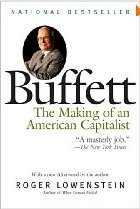While there have been countless books written regarding Warren Buffett’s track record in business and investing, along with many books of variable quality seeking to find formulas to replicate his success, there are only two full fledged biographies that have been written: The Making of an American Capitalist by Roger Lowenstein and The Snowball by Alice Schroeder.
Lowenstein’s book was published in 1995 and I read it shortly after it came out. Along with reading The Intelligent Investor around the same time, Lowenstein’s work was an inspiration for me to pursue a more careful study of value investing. Schroeder’s book was published in 2008 after several years of work that included unprecedented access to Buffett’s private papers and circle of business and personal contacts. I have read The Snowball as well and found it very insightful. In my opinion, students of Buffett should first read Lowenstein and then proceed to Schroeder. However, which book should be selected for those who only intend to read one biography on Warren Buffett?
Buffett: The Making of an American Capitalist
Roger Lowenstein began his study of Warren Buffett in 1991 during the Salomon Brothers rescue and had followed Buffett for years as a Wall Street Journal reporter and shareholder of Berkshire Hathaway. His book is a comprehensive account of Buffett’s life with an emphasis on aspects of the story that pertain to his development as a businessman and investor. While there are certainly abundant insights into Buffett’s formative years and personal life, it appears that the author was primarily focused on delivering the insights that a reader of a business book would wish to see covered in detail. Lowenstein did not have the kind of access to Buffett that Schroeder benefited from and the text is more sparse in terms of personal detail.
Obviously, due to the publication date of the book, the events of the past 14 years are not included. However, there is in depth treatment of the critical events of Buffett’s life up to the mid 1990s including his association with Benjamin Graham, his initial investment in Berkshire Hathaway, Buffett’s association with Charlie Munger, Berkshire’s entry into insurance, and much more. Those who wish to learn more about Buffett’s sense of business ethics will appreciate Lowenstein’s extensive coverage of the Salomon scandal and Buffett’s rescue of the firm. Overall, Lowenstein’s book is a very well written and concise account of Buffett’s life with an emphasis on his business dealings.
The Snowball: Warren Buffett and the Business of Life
Alice Schroeder worked as a Wall Street analyst and managing director at Morgan Stanley. She covered Berkshire Hathaway and impressed Warren Buffett with her insights regarding the company. Schroeder’s January 1999 report on Berkshire Hathaway pioneered the float based valuation model that many analysts use to estimate Berkshire Hathaway’s intrinsic value. In contrast with Lowenstein’s access to Warren Buffett (he elected to neither collaborate nor obstruct Lowenstein’s work), Schroeder had extensive access to Warren Buffett himself, his files, and network of business and personal contacts.
The result is a much more extensive portrait of Buffett as an individual, particularly in his formative years. While Lowenstein only had two relatively brief chapters on the first two decades of Buffett’s life, Schroeder devotes much more space to Buffett’s early years. The outcome of Schroeder’s greater access to Buffett’s family and friends is a very complete picture of Buffett’s early years. This alone makes purchasing the book worthwhile.
Schroeder goes on to cover the Buffett Partnership years in great detail, covering much of the same ground that Lowenstein included in his book. In my opinion, Lowenstein is more concise than Schroeder in terms of describing the Buffett Partnership as well as subsequent business events related to Berkshire Hathaway. Schroeder clearly interviewed more people and the result is that the book contains more quotations in many areas. Both approaches have merit. Suffice it to say that those who are looking for a more streamlined account of these years would favor Lowenstein, while those seeking a more personal account of these years would likely appreciate Schroeder’s detail.
While Lowenstein does include many details of Buffett’s personal life, Schroeder places a much more significant emphasis on topics such as Buffett’s unconventional arrangement in his marriage. While these topics have some interest from a human interest perspective, I did not really find the details insightful in terms of understanding Buffett’s genius as a businessman and investor. At times, I felt that the details provided were too extensive. I suppose that personal preference for such details may cause the reaction of other readers to differ from mine.
Of course, Schroeder’s book benefits from being written in 2008 rather than 1995 and the events of the last 13 years receive significant coverage. I particularly enjoyed the coverage of Buffett’s 1999 speech at Sun Valley warning about high stock valuations as well as the general coverage of Buffett’s business activities during the current decade.
Which to Choose?
In my opinion, readers would be well served to read both books. However, if a choice must be made, I would favor Snowball because of the more extensive coverage of Buffett’s youth as well as the coverage of the past decade. In conjunction with one or both of these biographies, readers should review Buffett’s letters to shareholders either as they were written or by reading Lawrence Cunningham’s The Essays of Warren Buffett which I reviewed last month.


